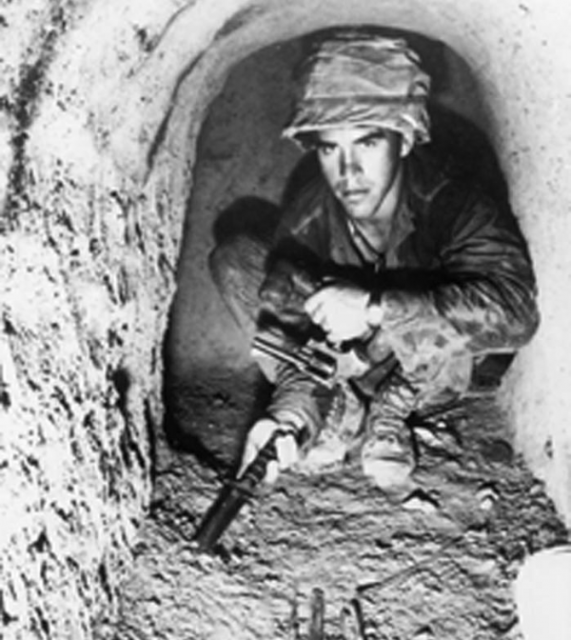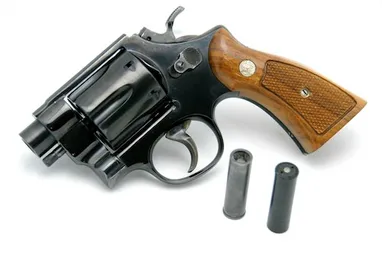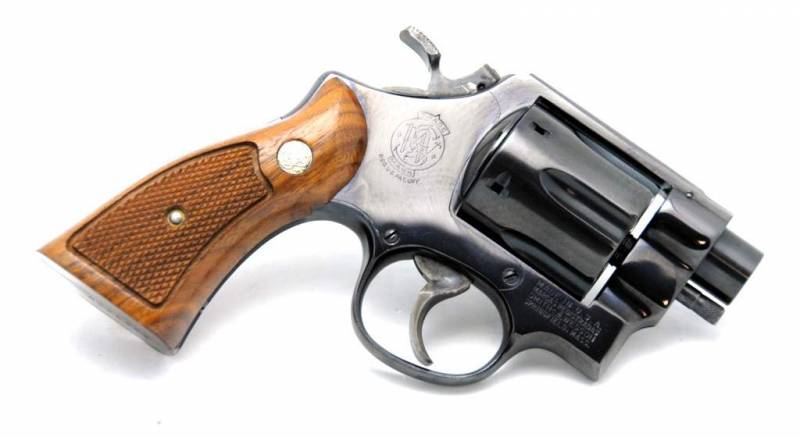
Vietnam has a hidden history of weapon development not known to many. Throughout the conflict, the United States military invested heavily in a wide variety of projects that aimed to better equip conventional forces for an unconventional war. This effort led to a great many projects being developed, but few that proved effective enough to move forward. One of the few is the subject of today’s article: the Quiet Special Purpose Revolver, aka the Tunnel Weapon.
The war in Vietnam was a brutal example of asymmetric warfare. One of the biggest challenges for American troops was the broad and effective use of tunnels by Vietnamese communist forces. These holes allowed enemy forces to hide themselves, their weapons, and more from American forces on the ground and in the air, creating a strategic advantage for the North Vietnamese. From a tactical perspective, the use of tunnels was genius. American forces weren’t ready for it, and it was a simple, inexpensive solution to a massive problem that was America’s superior military might.

American forces didn’t have any other option but to take to the tunnels, where the defenders had the advantage and the fighting became ultra-close and generally quite brutal. To become more efficient at storming these tunnels, American troops lneeded specialized weapons, and one such weapon was the Quiet Special Purpose Revolver.
Related: S&W Model 15: America’s last revolver is finally leaving service
The terrifying challenges facing Tunnel Rats
The sidearm of choice for American troops at the time was the M1911A1, and by all accounts, the general issue 1911 served well but wasn’t great for the tunnels. Tunnels did require a handgun, there was no doubt about that. Most of the time, the soldier storming the tunnel crawled on their hands and knees, which made the use of a long gun impossible. Accuracy was also an issue. Get on your hands and knees in a dark, tight tunnel and see how accurate you can be with a handgun in a firefight… it was probably even harder for the incredible men who climbed into these tunnels than we can even really appreciate now.
To make matters worse, handguns are tough to shoot well in general, and in a tunnel, any gunfire is extremely loud. In a dark tunnel, the flash is also quite bright. In these types of situations, a shotgun might be best… but good luck handling a shotgun in such tight quarters. So the Pentagon set about built a handgun-sized weapon that fired multiple projectiles at a time, with additional requirements to reduce both its sound and muzzle flash.
These special requests led to the development of the Quiet Special Purpose Revolver.
Related: The men with the green faces: The birth of the Navy SEALs in Vietnam
The basis for the Tunnel Weapon
AAI, or Advanced Armament Industries, worked with the Army to develop the QSPR in 1969. The requirements were simple. The weapon would fire multiple projectiles at a reduced sound level and be effective out to 50 feet. The weapon needed to be a repeater, be reloadable, and weigh less than 40 ounces.
When we say repeater, we don’t necessarily mean semi-automatic. We mean a weapon capable of firing more than a round before it needs to be reloaded. A revolver qualifies as a repeater, so it seems logical that a very big and (later on) very famous revolver became the basis for the Quiet Special Purpose Revolver.
With these requirements in mind, the engineers took an S&W Model 29 revolver and went to work. If you’re familiar with Dirty Harry, the movie detective with a bad attitude who famously wielded the big 44 Magnum pistol, then you’re already familiar with what would become the Quiet Special Purpose Revolver. The S&W Model 29 was a modern design for the time and featured a swing-out cylinder for quick reloading and a double-action design for easy follow-up shots. The S&W 29 held six rounds, and so would the QSPR.
Related: The 5 worst service weapons the US ever issued its troops
Building the QSPR
First, they cut the barrel down to nearly nothing and eliminated its unnecessary rifling entirely. In fact, the pistol was purposefully turned into a smoothbore weapon.
The nature of the ammunition ensured that a standard automatic cartridge could not be used. But no one could get away with calling the 44 Magnum round small. You can actually credit the case length of a 44 Magnum for ensuring the length of the cylinder was enough to handle a multi-projectile round.
The new round, called 10mm QSRP, dramatically reduced both flash and noise. Each shell contained ten pellets contained within a sabot. AAI hermetically sealed each round, and each case acted as its own disposable suppressor. A primer ignited gun powder which pushed a piston which then propelled the sabot full of shot through the outer seal.

The piston then resealed the cartridge, which contained most of the noise and reduced sound and almost entirely eliminated flash. The Quiet Special Purpose Revolver ended up weighing 38 ounces while being fairly short in overall length.
Related: The strangest Spec-Ops firearms in SOCOM’s armory
In-Service
According to numerous Army reports, a few weapons were built and sent to Vietnam for testing. Apparently, one ended up with MACVSOG, according to heavily redacted documents. It’s tough to find much in the way of field reports, but the Army Progress reported that it worked seemingly more or less just the way it was designed—good up close, but not great from a distance.
Digging through archives, I found a report from when Ranger team Oregon engaged seven to ten Vietnamese fighters. A Ranger armed with the QSRP engaged one enemy at 15 feet and immediately dropped him to the ground. That same Ranger fired twice at another enemy at 40 feet, but the enemy escaped.
The report called the weapon the .44 Mag tunnel weapon, and outlined a number of pressing issues that still needed to be worked out, including malfunctions and misfires caused by the new ammunition.
Another July 1972 report suggests that these issues were resolved by adding a “helper spring” and making changes to the ammunition’s design.
“A secondary or helper spring was added to the weapons mainspring that provided a 50 increase in firing pin energy and eliminated mainspring degradation. The ammunition was redesigned with fewer parts and the primer was repositioned and exposed at the base of the round for direct contact by the firing pin as in conventional ammunition. These design improvements resulted in not a single misfire throughout the development, assurance, and acceptance tests associated with this program.”
The result was so successful that this report seemingly granted the new gun its Quiet, Special-Purpose Revolver (QSPR) title along the way:
“The results of this evaluation indicated that the weapon system was well received primarily because the low firing noise permitted use of the weapon without giving away the users position,” the report reads.
“In addition to its tunnel exploration role, the weapon was used in ambush situations and in search and destroy operations. Because of this, the weapon is now designated the Quiet, Special-Purpose Revolver QSPR. “
Around this time, the war was ending, and as such, the QSPR project got sent to the back burner. When the war finally ended, so did any interest in a special-purpose revolver designed for the sort of fighting no one ever hoped to have to do again. Three samples exist to this day, two in Army Museums and one in the ATF reference collection. Despite how valuable such a weapon could be to the few who would need to wield it, the Tunnel WEapons was one of the many projects that started and stopped within the confines of the Vietnam war.
While the Tunnel Weapons might not have been successful, several more of those Vietnam efforts ultimately were. The list includes the beginnings of the M203, the Mk 19, and suppressors for special operations use. The QSPR revolver and its what-if history fascinates me.
2 replies on “QUIET SPECIAL PURPOSE REVOLVER: THE TUNNEL RAT’S LOST SIDEARM by Travis Pike”
Well written
Thanks and I think that I also think the writer did a fine job too!